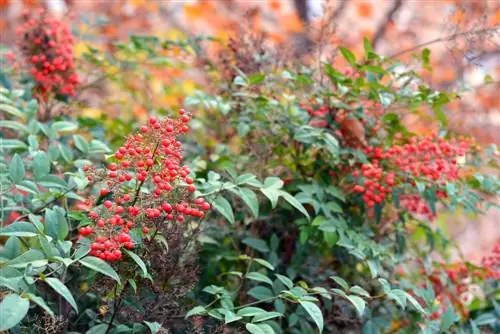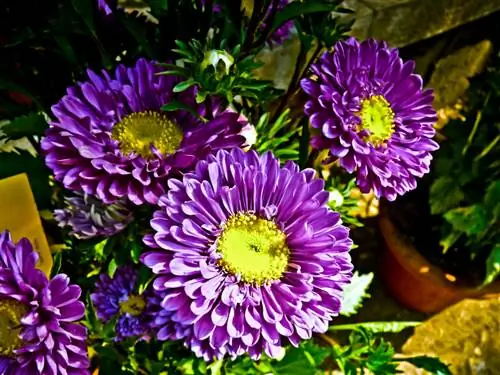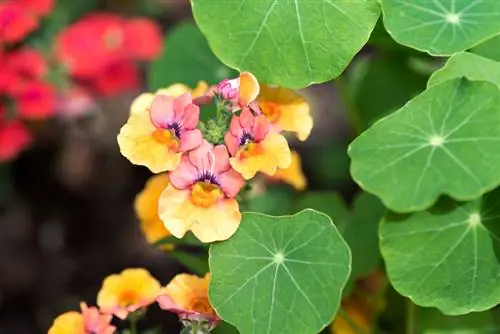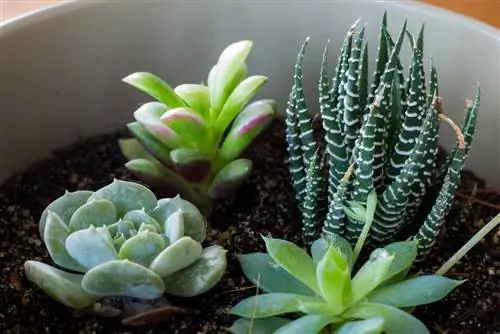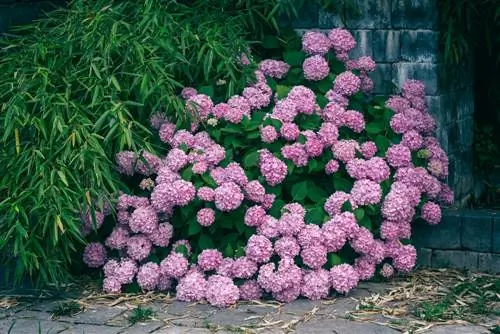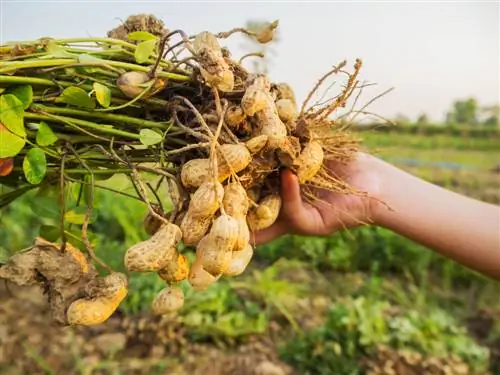- Author admin [email protected].
- Public 2023-12-16 16:46.
- Last modified 2025-06-01 06:02.
Sky bamboo has cult status in trendy garden design. For some, sacred bamboo is a colorful ambassador of Asian garden art, for others it is simply a beautiful ornamental shrub. Whether the floral trendsetter stylishly complements the garden image is not a question of perspective, but rather of location, planting and care. A check-up for hobby gardeners. Read an informative profile about the sky bamboo here. Instructions suitable for beginners explain how to properly cultivate Nandina in pots and garden beds.

What are the optimal conditions for sky bamboo?
Sky bamboo (Nandina) is a hardy, poisonous ornamental shrub with evergreen leaves, white flowers and red fruits. For optimal growth, it needs a partially shaded location, fresh, moist, slightly acidic soil and regular care such as watering and fertilizing.
Profile
- Scientific name: Nandina domestica
- Family: Barberry family (Berberidaceae)
- Growth type: evergreen shrub
- Winter hardiness: hardy
- Flower: white panicles
- Flowering period: June to August
- Leaf: pinnate
- Fruit: red berry
- Toxicity: poisonous
- Growth height: 100 to 200 cm
- Root: heart root without runners
- Use: ornamental shrub, hedge, potted plant
Winter hardiness
Basically, sky bamboo is attested to have a reliable winter hardiness of -18° Celsius. Depending on the location, cultivation and choice of variety, the degree of winter hardiness of a Nandina domestica, also known as sacred bamboo, drops significantly. How hardy the evergreen ornamental shrub in your garden actually is depends on these important factors:
- Winterhard: Original species planted in a wind-protected, partially shaded location in fresh, slightly acidic soil
- Conditionally hardy down to -10° C.: Variety planted in a protected, moist, nutrient-rich location with winter protection
- Partially hardy down to -5° C.: Heavenly bamboo in a pot with winter protection
Toxicity
Sky bamboo is poisonous in all parts. This also includes the red, spherical berries that adorn the bush in autumn and winter. Sacred bamboo is not recommended as a design element for the family garden.
If you still don't want to do without the Asian ornamental shrub, plant a male specimen of the original species. The male Nandina version only bears white flower panicles with stamens as a pollinator and is available in autumn without the seductive poisonous fruits. If there is no male sky bamboo in sight, you can plant a female shrub that does not produce toxic berries due to a lack of pollination on its flowers. But be careful: modern varieties always fruit because they thrive as hermaphroditic hybrids with male and female flowers.
Growth height
In terms of height, sky bamboo once again proves its flexibility. Of course, a Nandina domestica does not voluntarily stretch itself towards the sky in different sizes. Rather, competent breeders had a hand in it. The result is variable growth heights with these key data:
- Origin species: 150 to 200 cm
- Higher category hybrid varieties: 100 to 130 cm
- Medium category hybrid varieties: 80 to 120 cm
- Dwarf varieties: 40 to 70 cm
Sky bamboo unfolds its floral splendor regardless of its height. The following video invites you to take a look at the decorative finesse that adorn Nandina of all sizes. The English comments are of secondary importance. Just turn off the sound and enjoy the beauty of the sky bamboo:
Video: A look at the sky bamboo decorative components
Usage
From the temple gardens of Japan, heavenly bamboo found its way to Europe. Apart pinnate leaves in alternating colors, white flower spikes and bright red decorative berries inspire creative hobby gardeners to find imaginative uses in the garden and on the balcony. The following table provides an insight:
| ornamental shrub | Hedge | potted plant |
|---|---|---|
| Solitaire | Enclosure | Balcony privacy screen |
| House tree replacement | Privacy protection garbage can | Zen Garden Terrace |
| Japan Garden | Backdrop plant in the perennial bed | potted garden |
In the small garden, solitary sky bamboo sets decorative accents. The shrub is on the rise as a house tree replacement for the small front garden. As an authentic design component, sacred bamboo should not be missing in the Japanese garden. With its pretty pinnate leaves, sky bamboo acts as an opaque hedge to hide where garbage cans or bicycles are stored. Balcony gardeners appreciate the privacy factor of Nandine in the pot. Modeled after the temple gardens of Asia, heavenly bamboo gives your Zen garden the finishing touches and exudes Japanese flair in the potted garden.
Excursus
Sky bamboo is not bamboo
Don't let the German name for Nandina mislead you. Sky bamboo is a shrub whose roots obediently follow the rules. Real bamboo (Bambusoideae) is a species-rich subfamily of sweet grasses with invasive rhizomes that can only be controlled by a root barrier.
Planting sky bamboo - instructions for pots and beds
Planted correctly, sky bamboo is an ornament for the garden, balcony, terrace and winter garden. Lighting conditions, wind exposure, substrate quality, soil conditions and planting technique are the mainstays of a magical scenario at any time of the year. The following instructions explain how to expertly plant sky bamboo in pots and beds:
Plants in a pot - instructions
The ideal pot substrate is slightly acidic peat soil with a third of compost soil, 100 grams of horn shavings (€52.00 at Amazon) and two handfuls of lava granules. The right pot for sky bamboo is 20 centimeters larger in diameter than the root ball and has a water drain in the bottom of the pot. This is how you plant sky bamboo in a pot correctly:
- Place the root ball in a bucket with rainwater (do not remove the container yet)
- Create a 5 to 10 cm high drainage made of grit, expanded clay or lava granulate on the bottom of the bucket
- Place a water- and air-permeable fleece over the drainage
- Fill the substrate up to half the height
- Form a trough, insert the water-soaked, potted root ball
- Hold the bush straight with one hand, fill in the substrate with the other hand and press it down
- Set up in a partially shaded, wind-protected location
The sky bamboo is watered with rainwater or stale tap water until the saucer fills up.
Plants in the bed - no need for root barriers
The best time to plant is in spring so that sky bamboo is well rooted by the first frost. You can do without a root barrier because the shrub has no ambition to spread uncontrollably in the garden. You should not miss out on an extensive water bath for the root ball. How to plant Nandina domestica correctly:
- Location: semi-shaded, protected, fresh and moist, nutrient-rich, loose and permeable, pH value 5 to 6
- Dig a planting pit (twice larger than the root ball)
- Mix the excavated material half with ericaceous soil and several handfuls of horn shavings
- Unpot the water-soaked bush, plant it, press in the soil
- Form the pouring edge and coat it with rainwater
Care for sky bamboo - tips for pots and beds
The serenity of Japanese temple gardens is reflected in uncomplicated care at a level suitable for beginners. It's good to know that no root barriers will get in your way when fertilizing, watering or weeding. Pruning care is rarely part of the care program. Winter protection makes sense. This is how you care for heavenly bamboo in the pot and bed in an exemplary manner:
Fertilize
Fertilize sky bamboo in the pot every two weeks from May to August with liquid rhododendron fertilizer. Compost, ideally leaf compost, stimulates growth in the bed. At the beginning of May and mid-June, spread ripe compost soil over the root disc, rake in the fertilizer and then water with soft water. The nutrient supply ends at the beginning of September so that the branches mature before the start of winter. With unwoody shoot tips, a sky bamboo is vulnerable to frost damage.
Cutting
Pruning care is limited to occasional thinning in early spring. Cut off dead branches at the base. Take this opportunity to cut back shoots that are too long and out of shape. Extensive topiary is not necessary. The elegant, tautly upright figure unfolds most beautifully without cutting.
Unwanted growth of poisonous berries is the only reason for annual pruning. If you cut off all the withered flower spikes in July, the bright red fruits will not be able to form.
Pouring
Sky bamboo is a thirsty ornamental shrub. Keep the soil in the bed and pot constantly slightly moist. Water early in the morning on hot summer days and again after sunset if necessary. In winter the water supply continues. There is a risk of drought stress if there is a clear frost. The shrub continues to evaporate moisture through its evergreen pinnate leaves, which its roots can only supply sparsely from the frozen ground.
Wintering
In winter, sky bamboo cannot claim a home advantage like native, evergreen deciduous shrubs. Regardless of a certified winter hardiness of up to -18° Celsius, we recommend the following winter protection for beds and pots:
- In the bed: mulch the root disc with leaves and brushwood, cover the bush crown with breathable winter fleece
- In the bucket: Place the pot in front of the house wall on a wooden block, cover it with bubble wrap, mulch the substrate with bark mulch, leaves or straw, protect the branches with a cover made of translucent fleece
In the best case scenario, you can overwinter sky bamboo in a pot frost-free under glass, as is advantageous for all evergreen potted plants from distant countries. From November onwards, reserve a place for the valuable Asian tree in the bright, cool winter quarters with temperatures around 5° Celsius.
Popular varieties
As the only species of the genus Nandina, sky bamboo serves as a template for breeding multifaceted varieties for beds and balconies:
- Nandina domestica: Sky bamboo original species, up to 2 m high, white flowers from June, evergreen, red autumn color.
- Nandina domestica 'Obsessed': 50 to 70 cm high, red shoots, evergreen, white flowers, red berries, beautiful container plant.
- Sky Bamboo 'Firepower': 45 to 75 cm tall, moderately hardy, evergreen, pink-red autumn leaves, no runners.
- Sky bamboo 'Magical Lemon and Lime': 70 to 100 cm, two-tone foliage, white flowers from July, well hardy.
- Sky Bamboo 'Sienna Sunrise': 90 to 120 cm, green, pinnate leaves with red tips, early bloomer from April.
FAQ
What to do if the sky bamboo is damaged by frost?
Semi-ripe, unwoody shoot tips are susceptible to frost damage. Cut affected branches back to he althy wood. As the new growth season begins, your sky bamboo will regenerate and sprout again. As a preventative measure, fertilize the shrub for the last time for the season in early/mid-August so that herbaceous shoot tips mature and become woody in time.
Sky bamboo loses leaves. What’s the matter?
Leaf drop on the sky bamboo is a symptom of various causes. The shrub most often suffers from drought stress. Waterlogging causes the evergreen leaves to fall in the pot. When winter is bitterly cold, sacred bamboo sheds its evergreen leaves to protect itself. As a container plant, the ornamental shrub shows its dissatisfaction with a winter quarter that is too dark or warm by getting rid of its leaves.
Are sky bamboo fruits poisonous to dogs?
A sky bamboo is poisonous in all parts, including the bright red berries that adorn the shrub in fall and winter. The main ingredient is isoquinoline alkaloid, which causes nausea and vomiting when consumed in large quantities. You are on the safe side with a male sky bamboo that never bears fruit. Alternatively, we recommend cultivating a female Nandina without a male Celestial Bamboo in the immediate vicinity. This means there is no pollination and no fruits are formed that would tempt your dog to snack.
Can I plant sky bamboo in a sunny location?
A sunny location is possible as long as the evergreen leaves are protected from the blazing sun and sweltering heat. However, the thirsty shrub then needs to be watered more often than in a partially shaded place.
Does heavenly bamboo always rely on other plants for pollination?
No, nurseries and garden centers offer many hermaphrodite Nandina varieties with male and female flowers on the same bush. This includes Nandina domestica 'Richmond', a medium-sized ornamental shrub with red shoots, green summer leaves and scarlet autumn color.
Are the berries that decorate the sky bamboo in autumn edible?
No, the bright red berries on the sky bamboo are poisonous and are only suitable as ornaments.
Should you plant sky bamboo with a root barrier?
Sky bamboo is a shrub from the barberry family and does not form runners like you know from real bamboo. A root barrier is not necessary.

